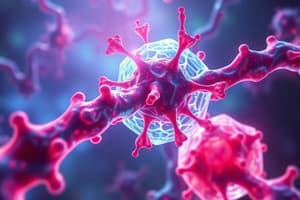Podcast
Questions and Answers
What is the principal function of cellular receptors in the immune system?
What is the principal function of cellular receptors in the immune system?
- To facilitate antigen processing and presentation
- To regulate lymphocyte maturation
- To detect external stimuli and trigger responses (correct)
- To produce antigens
What distinguishes B and T lymphocytes in terms of antigen recognition?
What distinguishes B and T lymphocytes in terms of antigen recognition?
- Response to different types of antigens
- Location of maturation within the body
- Expression of membrane-bound antibodies and T cell receptors (correct)
- Expression of different cytokines
Why is it important for antigen receptors of lymphocytes to be able to distinguish between many closely related chemical structures?
Why is it important for antigen receptors of lymphocytes to be able to distinguish between many closely related chemical structures?
- To eliminate harmful pathogens
- To preserve useful specificities (correct)
- To regulate immune responses
- To avoid self reactivity
What does clonally distributed mean in the context of antigen receptors of lymphocytes?
What does clonally distributed mean in the context of antigen receptors of lymphocytes?
Which portion of the antibody molecule is responsible for effector functions?
Which portion of the antibody molecule is responsible for effector functions?
What contributes most to antigen binding due to its great variability?
What contributes most to antigen binding due to its great variability?
Which type of Ig heavy chain protein results in a membrane-bound antibody on naive B cells?
Which type of Ig heavy chain protein results in a membrane-bound antibody on naive B cells?
What is the core structure of antibody molecules containing?
What is the core structure of antibody molecules containing?
Which process allows B cells to change their heavy-chain production and secrete various isotypes?
Which process allows B cells to change their heavy-chain production and secrete various isotypes?
What is the structure of antibodies, such as IgG and IgM, consisting of?
What is the structure of antibodies, such as IgG and IgM, consisting of?
What are the functionally distinct portions of antibodies identified through proteolysis?
What are the functionally distinct portions of antibodies identified through proteolysis?
Which portion of the antibody molecule contains antigen-binding sites?
Which portion of the antibody molecule contains antigen-binding sites?
How many identical antigen-binding sites does the core structure of an antibody molecule contain?
How many identical antigen-binding sites does the core structure of an antibody molecule contain?
What is the process by which B cells can stimulate the production of various heavy-chain isotypes upon antigen exposure?
What is the process by which B cells can stimulate the production of various heavy-chain isotypes upon antigen exposure?
Which portion of the antibody molecule contains constant domains responsible for effector functions?
Which portion of the antibody molecule contains constant domains responsible for effector functions?
What are the antigens receptors on naive B cells primarily composed of?
What are the antigens receptors on naive B cells primarily composed of?
What is the average half-life of IgG antibodies?
What is the average half-life of IgG antibodies?
What are the two types of light chains that contribute to forming the antigen-binding surface of antibodies?
What are the two types of light chains that contribute to forming the antigen-binding surface of antibodies?
What are epitopes?
What are epitopes?
How is antibody affinity measured?
How is antibody affinity measured?
Which antibody isotype is primarily involved in defense against microbes?
Which antibody isotype is primarily involved in defense against microbes?
What is the typical number of antigen-binding sites for each antibody molecule?
What is the typical number of antigen-binding sites for each antibody molecule?
What type of epitopes are contiguous amino acid sequences?
What type of epitopes are contiguous amino acid sequences?
What is the phenomenon called when antibodies produced against one antigen can bind to structurally similar antigens?
What is the phenomenon called when antibodies produced against one antigen can bind to structurally similar antigens?
What contributes to forming the antigen-binding surface of antibodies?
What contributes to forming the antigen-binding surface of antibodies?
What does antibody avidity refer to?
What does antibody avidity refer to?
What type of interactions do antibodies use to bind to antigens?
What type of interactions do antibodies use to bind to antigens?
What are the distinct features, shapes, and functions associated with different antibody isotypes called?
What are the distinct features, shapes, and functions associated with different antibody isotypes called?
What is the main function of the immune repertoire?
What is the main function of the immune repertoire?
What is the specificity of B cell antigen receptors?
What is the specificity of B cell antigen receptors?
What ensures the specificity of T cell antigen receptors for infected or tumor cells?
What ensures the specificity of T cell antigen receptors for infected or tumor cells?
What is the function of complementarity-determining regions (CDRs) in antigen receptor polypeptides?
What is the function of complementarity-determining regions (CDRs) in antigen receptor polypeptides?
What is the result of antigen binding to the extracellular portions of antigen receptors?
What is the result of antigen binding to the extracellular portions of antigen receptors?
What is the composition of the B cell receptor (BCR) complex?
What is the composition of the B cell receptor (BCR) complex?
What is the function of T cell receptors (TCR) complex?
What is the function of T cell receptors (TCR) complex?
What leads to lymphocyte division, differentiation, effector functions, or death following antigen recognition?
What leads to lymphocyte division, differentiation, effector functions, or death following antigen recognition?
What distinguishes B cell and T cell antigen receptors in terms of their antigen recognition properties?
What distinguishes B cell and T cell antigen receptors in terms of their antigen recognition properties?
What is the role of variable regions in antigen receptor polypeptides?
What is the role of variable regions in antigen receptor polypeptides?
What do intracellular signals associated with recognition lead to?
What do intracellular signals associated with recognition lead to?
What is the primary difference in the form of antibodies and TCRs?
What is the primary difference in the form of antibodies and TCRs?
Which proteins are associated with the signaling functions of BCRs?
Which proteins are associated with the signaling functions of BCRs?
What is the primary function of secreted antibodies?
What is the primary function of secreted antibodies?
How is antigen recognition mediated by antibodies' variable regions?
How is antigen recognition mediated by antibodies' variable regions?
What is the typical requirement for BCR signaling?
What is the typical requirement for BCR signaling?
What is the approximate potential for distinct specificities in BCRs?
What is the approximate potential for distinct specificities in BCRs?
Which type of antigens are recognized by TCRs?
Which type of antigens are recognized by TCRs?
What is the affinity range of antigen binding for TCRs?
What is the affinity range of antigen binding for TCRs?
What are the effector functions mediated by TCRs?
What are the effector functions mediated by TCRs?
What form do TCRs primarily exist in?
What form do TCRs primarily exist in?
Which region of antibodies recognizes microbial antigens?
Which region of antibodies recognizes microbial antigens?
What is the primary function of membrane-bound BCRs on B cells?
What is the primary function of membrane-bound BCRs on B cells?
Flashcards are hidden until you start studying
Study Notes
- Antigen receptors and associated signaling proteins form BCR and TCR complexes.
- BCR typically requires binding of multiple receptors to adjacent antigen molecules for signaling.
- Antibodies:
- Membrane form: Ig alpha, Ig beta, and antigen bound to plasma membrane leading to signal transduction.
- Secreted form: Secreted antibodies performing effector functions like complement fixation and phagocyte binding.
- Types of antigens recognized: macromolecules (proteins, polysaccharides, lipids, nucleic acids), small chemicals, conformational and linear epitopes.
- Diversity: each clone has a unique specificity, potential for approximately 10^11 distinct specificities.
- Antigen recognition is mediated by variable (V) regions of heavy and light chains.
- Antigen binding site: made up of three CDRs from V sub H and three CDRs from V sub L.
- Affinity of antigen binding: Kd 10^-7 to 10^-11 M, average affinity increases during immune responses.
- Signaling functions are mediated by proteins (Ig alpha and Ig beta) associated with membrane Ig.
- Effector functions are mediated by constant (C) regions of secreted Ig.
- Changes in constant regions: heavy chain class switching, change from membrane to secretory Ig.
- TCRs:
- Membrane form: antigen bound to MHC above and TCR below, CDR3 and zeta receptors for signal transduction.
- Secreted form: none.
- Types of antigens recognized: mainly peptides displayed by MHC molecules on APCs, linear epitopes.
- Diversity: each clone has a unique specificity, potential for approximately 10^16 distinct specificities.
- Antigen recognition is mediated by variable (V) regions of alpha and beta chains.
- Antigen binding site: made up of three CDRs from V alpha and three CDRs from V beta.
- Affinity of antigen binding: Kd 10^-5 to 10^-7 M, no change during immune responses.
- Signaling functions are mediated by proteins (CDR3 and zeta) associated with the TCR.
- Effector functions are not mediated by TCRs.
- Antibodies exist as membrane-bound antigen receptors on B cells and as secreted proteins (immunoglobulins), providing protection against microbes.
- Antibodies recognize microbial antigens through their variable domains, and their constant regions bind to other molecules for effector functions.
- TCRs exist only as membrane receptors on T cells, involved solely in antigen recognition and T cell activation.
Studying That Suits You
Use AI to generate personalized quizzes and flashcards to suit your learning preferences.




